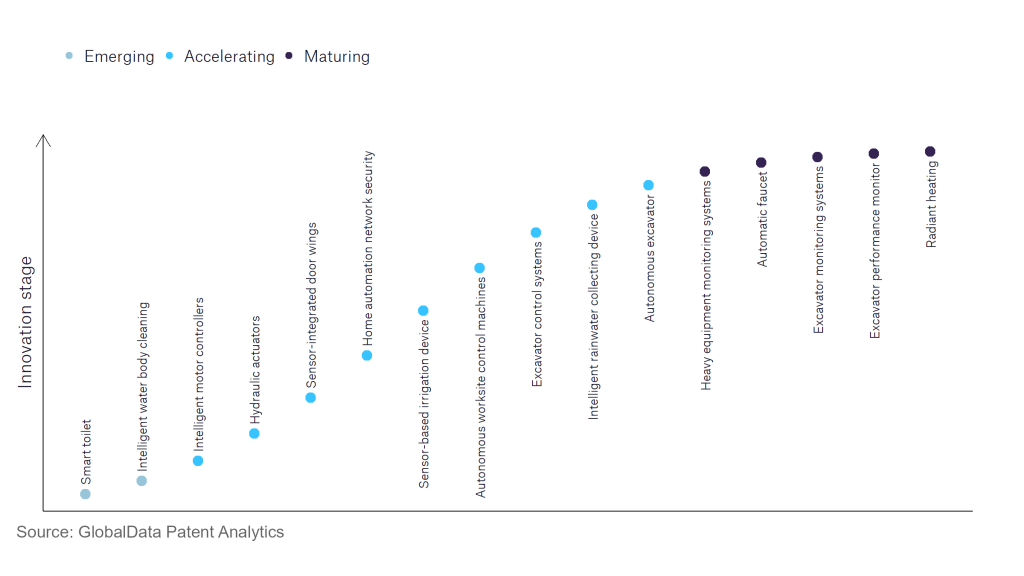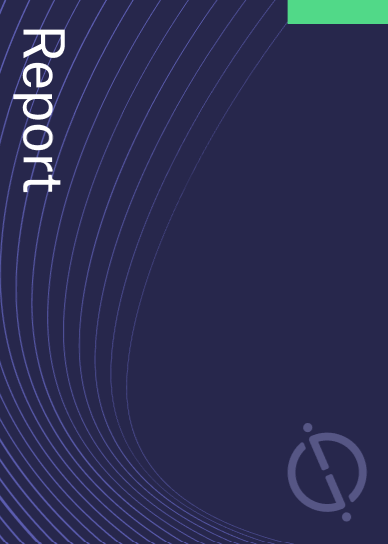The construction industry continues to be a hotbed of innovation, with activity driven by the increased prominence of environmental sustainability, circular construction and workplace safety, and the growing importance of technologies such as robotics, the Internet of Things (IoT) and modular construction. In the last three years alone, there have been over 248,000 patents filed and granted in the construction industry, according to GlobalData’s report on Internet of Things in Construction: Hydraulic actuators. Buy the report here.
However, not all innovations are equal and nor do they follow a constant upward trend. Instead, their evolution takes the form of an S-shaped curve that reflects their typical lifecycle from early emergence to accelerating adoption, before finally stabilising and reaching maturity.
Identifying where a particular innovation is on this journey, especially those that are in the emerging and accelerating stages, is essential for understanding their current level of adoption and the likely future trajectory and impact they will have.
80+ innovations will shape the construction industry
According to GlobalData’s Technology Foresights, which plots the S-curve for the construction industry using innovation intensity models built on over 179,000 patents, there are 80+ innovation areas that will shape the future of the industry.
Within the emerging innovation stage, intelligent water body cleaning is a disruptive technology that is in the early stages of application and should be tracked closely. Intelligent motor controllers, hydraulic actuators, and sensor-integrated door wings are some of the accelerating innovation areas, where adoption has been steadily increasing. Among maturing innovation areas are automatic faucet and excavator monitoring systems, which are now well established in the industry.
Innovation S-curve for Internet of Things in the construction industry

Hydraulic actuators are a key innovation area in Internet of Things
A hydraulic actuator uses hydraulic energy to generate mechanical work, typically through the pressurising of non-compressible hydraulic oil. Hydraulic actuators have a number of advantages, including their durability, affordability and their ability to generate substantial forces.
GlobalData’s analysis also uncovers the companies at the forefront of each innovation area and assesses the potential reach and impact of their patenting activity across different applications and geographies. According to GlobalData, there are 20+ companies, spanning technology vendors, established construction companies, and up-and-coming start-ups engaged in the development and application of hydraulic actuators.
Key players in hydraulic actuators – a disruptive innovation in the construction industry
‘Application diversity’ measures the number of different applications identified for each relevant patent and broadly splits companies into either ‘niche’ or ‘diversified’ innovators.
‘Geographic reach’ refers to the number of different countries each relevant patent is registered in and reflects the breadth of geographic application intended, ranging from ‘global’ to ‘local’.
Patent volumes related to hydraulic actuators
Source: GlobalData Patent Analytics
Leading innovators in the development of hydraulic actuators include Caterpillar, a manufacturer of construction, transportation and energy equipment. Key hydraulic actuator patents by Caterpillar include a hydraulic circuit and a working machine that are capable of improving the initial speed of contraction of a hydraulic cylinder and ensuring a necessary pump flow rate even when a working fluid is being accumulated in an accumulator. Hitachi is another leading innovator in the development of hydraulic actuators, with key patents including a hydraulic control system for a work machine that is capable of reducing the loss caused by flow division, while reducing a decrease in the speed of a hydraulic actuator due to a combined operation.
In terms of application diversity, leading companies in the hydraulic actuator space include Moog, a designer, manufacturer and integrator of precision control components and systems, and Jiangsu Hengli Hydraulic, a manufacturer of hydraulic components and systems. By means of geographical reach, Sandvik and Doosan are the leading players.
To further understand the key themes and technologies disrupting the construction industry, access GlobalData’s latest thematic research report on Internet of Things (IoT) in Construction.
Data Insights
From

The gold standard of business intelligence.
Blending expert knowledge with cutting-edge technology, GlobalData’s unrivalled proprietary data will enable you to decode what’s happening in your market. You can make better informed decisions and gain a future-proof advantage over your competitors.



